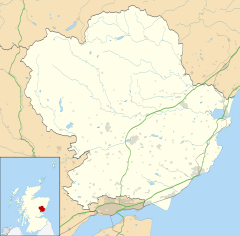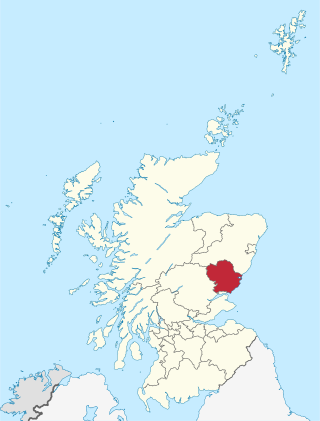
Angus is one of the 32 local government council areas of Scotland, a registration county and a lieutenancy area. The council area borders Aberdeenshire, Dundee City and Perth and Kinross. Main industries include agriculture and fishing. Global pharmaceuticals company GSK has a significant presence in Montrose in the north of the county.

The National is the national art gallery of Scotland. It is located on The Mound in central Edinburgh, close to Princes Street. The building was designed in a neoclassical style by William Henry Playfair, and first opened to the public in 1859.

Arbroath or Aberbrothock is a former royal burgh and the largest town in the council area of Angus, Scotland, with a population of 23,902. It lies on the North Sea coast, some 16 miles (26 km) east-northeast of Dundee and 45 miles (72 km) south-southwest of Aberdeen.

The Royal Scottish Academy building, the home of the Royal Scottish Academy, is an art museum in Edinburgh, Scotland. It is situated at the junction of The Mound and Princes Street in the centre of the city. It was built by William Henry Playfair in 1822-6. Along with the adjacent National Gallery of Scotland, their neo-classical design helped to transform Edinburgh into the cityscape known as "the Athens of the North". Today the structure is a Category A listed building.
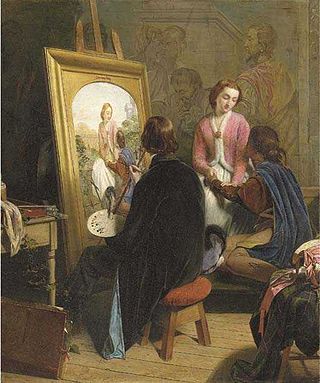
The Clique was a group of English artists formed by Richard Dadd in the late 1830s. Other members were Augustus Egg, Alfred Elmore, William Powell Frith, Henry Nelson O'Neil, John Phillip and Edward Matthew Ward.

The Royal Scottish Academy (RSA) is the country’s national academy of art. It promotes contemporary Scottish art.
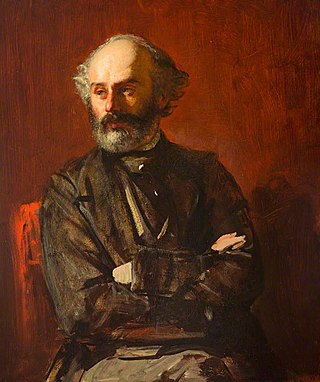
John Phillip was a Victorian era Scottish painter best known for his portrayals of Spanish life. He started painting these studies after a trip to Spain in 1851. He was nicknamed John 'Spanish' Phillip.

St Vigeans is a small village and parish in Angus, Scotland, immediately to the north of Arbroath. Originally rural, it is now more or less a suburb of the town of Arbroath.

Arbirlot is a village in a rural parish of the same name in Angus, Scotland. The current name is usually presumed to be a contraction of Aberelliot or Aber-Eliot - both meaning the mouth of the Elliot. It is situated west of Arbroath. The main village settlement is on the Elliot Water, 2+1⁄2 miles (4 km) from Arbroath. There is a Church of Scotland church and a primary school. The school lies 1 mile (1.6 km) further west, in the approximate geographic centre of the parish.

Ethie Castle is a 15,091 square feet (1,402.0 m2) 14th-century castle, situated around 3 miles north of the fishing town of Arbroath in Angus, Scotland.

William Kidd H.R.S.A. was a prolific Scottish artist known for his comic depictions of cosy domestic scenes in romantic-era Scotland and England. He also illustrated works of various authors including Sir Walter Scott and Robert Burns.
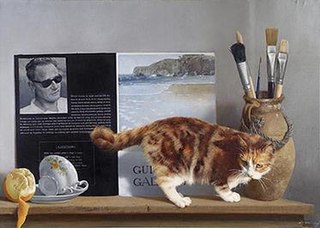
Patrick Anthony Hennessy RHA was an Irish realist painter. He was known for his highly finished still lifes, landscapes and trompe l'oeil paintings. The hallmark of his style was his carefully observed realism and his highly finished surfaces, the result of a virtuoso painting technique. He was brought up in Arbroath by his mother and step-father, his father having been killed during World War One. He attended Dundee School of Art where he met his lifelong companion, the painter Henry (Harry) Robertson Craig. Two of his paintings were accepted in 1939 at the Royal Scottish Academy for their Annual Exhibition. For the next 29 years he lived in Ireland with extended trips abroad. He was elected a member of the Royal Hibernian Academy in 1949. The Hendriks Gallery in Dublin and the Guildhall Galleries in Chicago were the main outlets for his work. In the late 1960s he moved permanently to Tangier and then, after suffering ill health, to the Algarve. He died in London.
Arbroath High School is a six-year, all-through comprehensive school situated on the west side of Arbroath, Angus, Scotland. It moved into its present building in 1985.

Graham Fagen is a Scottish artist living and working in Glasgow, Scotland. He has exhibited internationally at the Busan Biennale, South Korea (2004), the Art and Industry Biennial, New Zealand (2004), the Venice Biennale (2003) and represented Scotland at the 56th Venice Biennale in 2015 in a presentation curated and organised by Hospitalfield. In Britain he has exhibited at the Victoria & Albert Museum, Tate Britain and the Institute of Contemporary Arts, London. In 1999 he was invited by the Imperial War Museum, London to work as the Official War Artist for Kosovo.
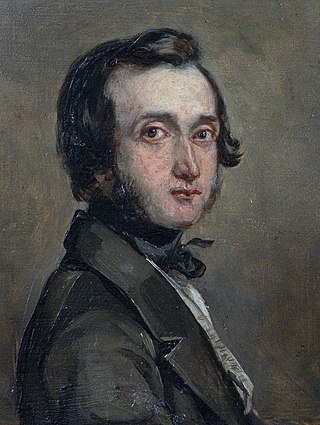
Patrick Allan Fraser was a Scottish painter and architect.
James Cowie was a Scottish painter and teacher. The quality of his portrait paintings and his strong linear style made him among the most individual Scottish painters of the 1920s and 1930s. His work displayed meticulous draughtsmanship which was based on his studies of the Old Masters and his use of many preparatory drawings.

The Hospital of St John the Baptist, at Arbroath, Scotland, was founded in the early 14th century by the monastic community at Arbroath Abbey. The exact date for the foundation is uncertain, but it is first recorded in 1325 during the time that Bernard of Kilwinning (1324–c.1328) was Abbot of Arbroath. The Abbey itself was founded in 1178 by King William the Lion for a group of Tironensian Benedictine monks from Kelso Abbey. It was consecrated in 1197. It is possible that the hospital was used by travellers, as a chantry or possibly almshouse.

John Hutchison was a Scottish sculptor based in Edinburgh. He was the son of an unnamed builder, and his artistic life began as a thirteen-year-old woodcarving apprentice. He attended art school in the evenings, then later became a student at the Trustees Academy. and attracted the patronage of its owner, Patrick Allan Fraser, who gave him commissions to fund his study in Rome. Although after Rome he continued to enjoy ancient Roman sculptural themes, he remained in Edinburgh for the rest of his life, working in wood, clay and marble, and concentrating on portraiture of Scottish people, and images of Scottish myth and history. He created the bust of Sir Walter Scott in Poets' Corner in Westminster Abbey. He was a successful artist who received commissions from Queen Victoria.

Gourlay Steell RSA (1819–1894) was a 19th-century Scottish artist.

Blackcraig Castle is a Baronial mansion house dating from 1856 in Perthshire, Scotland, close to the towns of Ballintuim and Blairgowrie on the banks of the River Ardle. It was built in 1856 by Patrick Allan Fraser, a prominent Scottish artist and architect, and is designated as a Class B-listed building, with its walled garden A-listed. It has undergone extensive renovations/modernisation in recent years to return it to its full former glory and remains one of the finest examples of Baronial architecture in Scotland.

